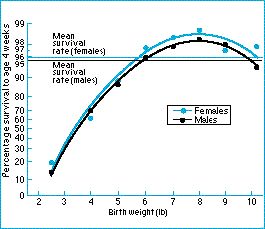Natural selection and variation - What are the types of natural selection?

An example of stabilizing selection: birth weight in humans
Studies of birth weight in humans have provided good examples of stabilizing selection: the graph illustrates a classic result for a sample in London, UK, in 1935 - 1946 and similar results have been found in New York, Italy, and Japan. Babies that are heavier or lighter than average did not survive as well as babies of average weight.
Stabilizing selection has probably operated on birth weight in human populations from the time of the evolutionary expansion of our brains about 1 - 2 million years ago until the 20th century. In most of the world it still does. However, in the 50 years since Karn and Penrose’s study, the force of stabilizing selection on birth weight has relaxed because of improved care for premature deliveries (the main cause of lighter babies) and increased frequencies of Caesarean deliveries for babies that are large relative to the mother (the lower survival of heavier babies was mainly due to injury to the baby or the mother during birth). Now, in the 1990s in wealthy countries, the stabilizing selection that had been operating on human birth weight for over a million years has all but disappeared.
Figure: stabilizing selection on human birth weight. Infants weighing 8 lb at birth have a higher survival rate than heavier or lighter infants. The graph is based on infants born in London from 1935 to 1946. From Karn and Penrose (1951).
| Next |



